Land Law: Easements and Covenants
VerifiedAdded on 2020/02/05
|10
|4240
|496
Essay
AI Summary
This essay delves into the intricacies of easements and covenants within the framework of land law in the UK. It discusses the definitions, types, and legal implications of easements, including express grants, implied grants, and prescription grants. The essay also examines the role of local authorities in appropriating land for planning purposes and the statutory heritage that governs these processes. Furthermore, it highlights the challenges and contradictions present in current land law, particularly regarding the relationship between private rights and public planning. The analysis is supported by case law and references to relevant legislation, emphasizing the need for clarity and reform in the provisions governing easements and covenants.

LAND LAW
Paraphrase This Document
Need a fresh take? Get an instant paraphrase of this document with our AI Paraphraser
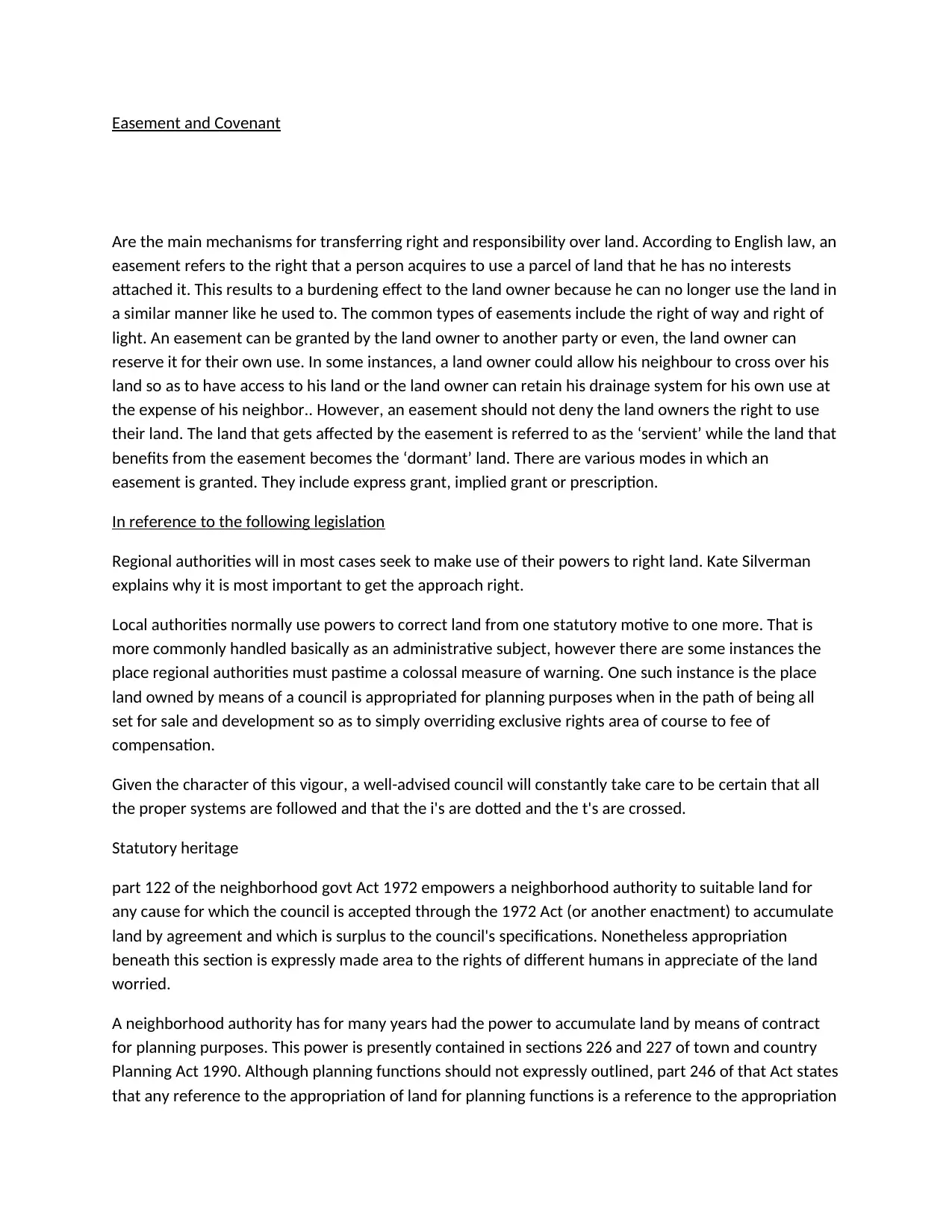
Easement and Covenant
Are the main mechanisms for transferring right and responsibility over land. According to English law, an
easement refers to the right that a person acquires to use a parcel of land that he has no interests
attached it. This results to a burdening effect to the land owner because he can no longer use the land in
a similar manner like he used to. The common types of easements include the right of way and right of
light. An easement can be granted by the land owner to another party or even, the land owner can
reserve it for their own use. In some instances, a land owner could allow his neighbour to cross over his
land so as to have access to his land or the land owner can retain his drainage system for his own use at
the expense of his neighbor.. However, an easement should not deny the land owners the right to use
their land. The land that gets affected by the easement is referred to as the ‘servient’ while the land that
benefits from the easement becomes the ‘dormant’ land. There are various modes in which an
easement is granted. They include express grant, implied grant or prescription.
In reference to the following legislation
Regional authorities will in most cases seek to make use of their powers to right land. Kate Silverman
explains why it is most important to get the approach right.
Local authorities normally use powers to correct land from one statutory motive to one more. That is
more commonly handled basically as an administrative subject, however there are some instances the
place regional authorities must pastime a colossal measure of warning. One such instance is the place
land owned by means of a council is appropriated for planning purposes when in the path of being all
set for sale and development so as to simply overriding exclusive rights area of course to fee of
compensation.
Given the character of this vigour, a well-advised council will constantly take care to be certain that all
the proper systems are followed and that the i's are dotted and the t's are crossed.
Statutory heritage
part 122 of the neighborhood govt Act 1972 empowers a neighborhood authority to suitable land for
any cause for which the council is accepted through the 1972 Act (or another enactment) to accumulate
land by agreement and which is surplus to the council's specifications. Nonetheless appropriation
beneath this section is expressly made area to the rights of different humans in appreciate of the land
worried.
A neighborhood authority has for many years had the power to accumulate land by means of contract
for planning purposes. This power is presently contained in sections 226 and 227 of town and country
Planning Act 1990. Although planning functions should not expressly outlined, part 246 of that Act states
that any reference to the appropriation of land for planning functions is a reference to the appropriation
Are the main mechanisms for transferring right and responsibility over land. According to English law, an
easement refers to the right that a person acquires to use a parcel of land that he has no interests
attached it. This results to a burdening effect to the land owner because he can no longer use the land in
a similar manner like he used to. The common types of easements include the right of way and right of
light. An easement can be granted by the land owner to another party or even, the land owner can
reserve it for their own use. In some instances, a land owner could allow his neighbour to cross over his
land so as to have access to his land or the land owner can retain his drainage system for his own use at
the expense of his neighbor.. However, an easement should not deny the land owners the right to use
their land. The land that gets affected by the easement is referred to as the ‘servient’ while the land that
benefits from the easement becomes the ‘dormant’ land. There are various modes in which an
easement is granted. They include express grant, implied grant or prescription.
In reference to the following legislation
Regional authorities will in most cases seek to make use of their powers to right land. Kate Silverman
explains why it is most important to get the approach right.
Local authorities normally use powers to correct land from one statutory motive to one more. That is
more commonly handled basically as an administrative subject, however there are some instances the
place regional authorities must pastime a colossal measure of warning. One such instance is the place
land owned by means of a council is appropriated for planning purposes when in the path of being all
set for sale and development so as to simply overriding exclusive rights area of course to fee of
compensation.
Given the character of this vigour, a well-advised council will constantly take care to be certain that all
the proper systems are followed and that the i's are dotted and the t's are crossed.
Statutory heritage
part 122 of the neighborhood govt Act 1972 empowers a neighborhood authority to suitable land for
any cause for which the council is accepted through the 1972 Act (or another enactment) to accumulate
land by agreement and which is surplus to the council's specifications. Nonetheless appropriation
beneath this section is expressly made area to the rights of different humans in appreciate of the land
worried.
A neighborhood authority has for many years had the power to accumulate land by means of contract
for planning purposes. This power is presently contained in sections 226 and 227 of town and country
Planning Act 1990. Although planning functions should not expressly outlined, part 246 of that Act states
that any reference to the appropriation of land for planning functions is a reference to the appropriation
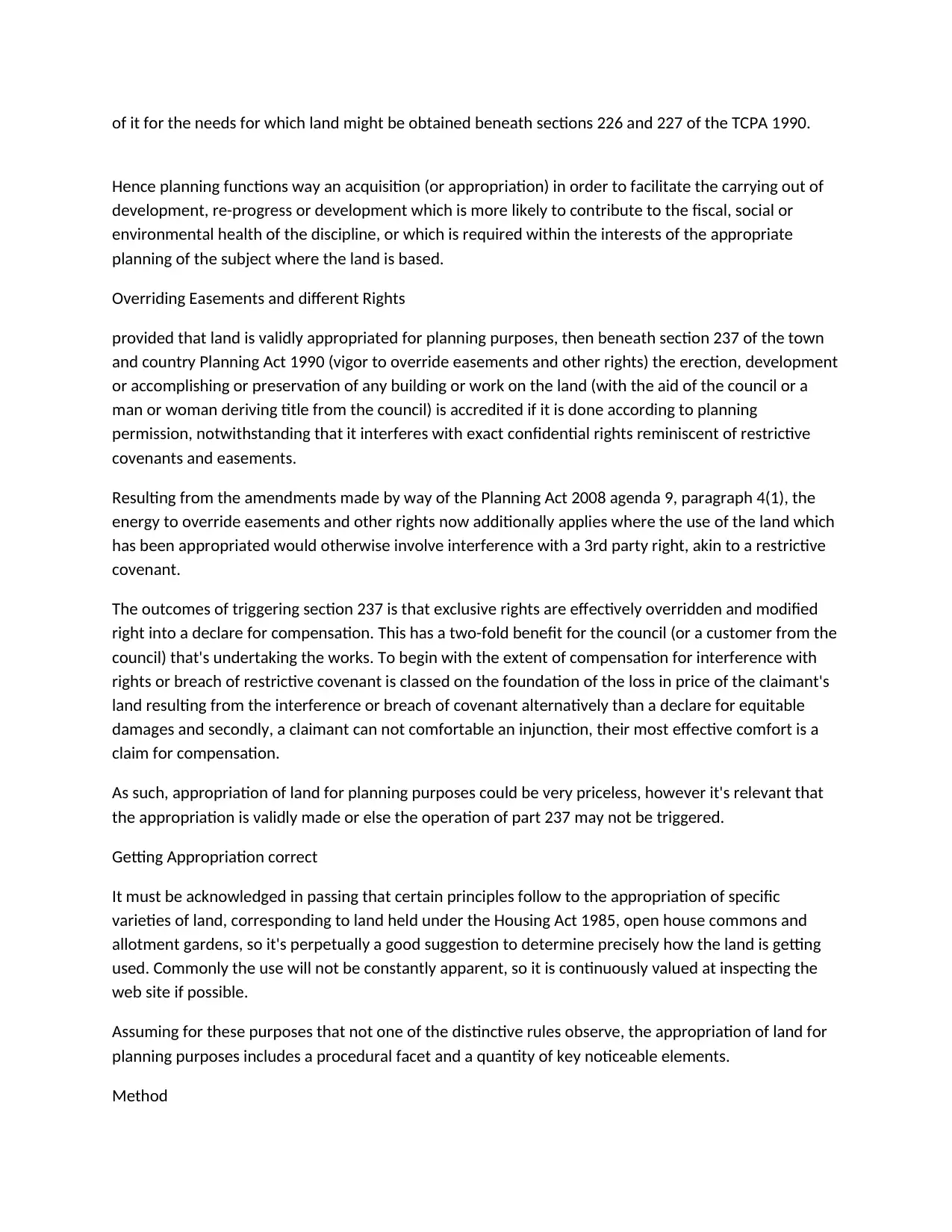
of it for the needs for which land might be obtained beneath sections 226 and 227 of the TCPA 1990.
Hence planning functions way an acquisition (or appropriation) in order to facilitate the carrying out of
development, re-progress or development which is more likely to contribute to the fiscal, social or
environmental health of the discipline, or which is required within the interests of the appropriate
planning of the subject where the land is based.
Overriding Easements and different Rights
provided that land is validly appropriated for planning purposes, then beneath section 237 of the town
and country Planning Act 1990 (vigor to override easements and other rights) the erection, development
or accomplishing or preservation of any building or work on the land (with the aid of the council or a
man or woman deriving title from the council) is accredited if it is done according to planning
permission, notwithstanding that it interferes with exact confidential rights reminiscent of restrictive
covenants and easements.
Resulting from the amendments made by way of the Planning Act 2008 agenda 9, paragraph 4(1), the
energy to override easements and other rights now additionally applies where the use of the land which
has been appropriated would otherwise involve interference with a 3rd party right, akin to a restrictive
covenant.
The outcomes of triggering section 237 is that exclusive rights are effectively overridden and modified
right into a declare for compensation. This has a two-fold benefit for the council (or a customer from the
council) that's undertaking the works. To begin with the extent of compensation for interference with
rights or breach of restrictive covenant is classed on the foundation of the loss in price of the claimant's
land resulting from the interference or breach of covenant alternatively than a declare for equitable
damages and secondly, a claimant can not comfortable an injunction, their most effective comfort is a
claim for compensation.
As such, appropriation of land for planning purposes could be very priceless, however it's relevant that
the appropriation is validly made or else the operation of part 237 may not be triggered.
Getting Appropriation correct
It must be acknowledged in passing that certain principles follow to the appropriation of specific
varieties of land, corresponding to land held under the Housing Act 1985, open house commons and
allotment gardens, so it's perpetually a good suggestion to determine precisely how the land is getting
used. Commonly the use will not be constantly apparent, so it is continuously valued at inspecting the
web site if possible.
Assuming for these purposes that not one of the distinctive rules observe, the appropriation of land for
planning purposes includes a procedural facet and a quantity of key noticeable elements.
Method
Hence planning functions way an acquisition (or appropriation) in order to facilitate the carrying out of
development, re-progress or development which is more likely to contribute to the fiscal, social or
environmental health of the discipline, or which is required within the interests of the appropriate
planning of the subject where the land is based.
Overriding Easements and different Rights
provided that land is validly appropriated for planning purposes, then beneath section 237 of the town
and country Planning Act 1990 (vigor to override easements and other rights) the erection, development
or accomplishing or preservation of any building or work on the land (with the aid of the council or a
man or woman deriving title from the council) is accredited if it is done according to planning
permission, notwithstanding that it interferes with exact confidential rights reminiscent of restrictive
covenants and easements.
Resulting from the amendments made by way of the Planning Act 2008 agenda 9, paragraph 4(1), the
energy to override easements and other rights now additionally applies where the use of the land which
has been appropriated would otherwise involve interference with a 3rd party right, akin to a restrictive
covenant.
The outcomes of triggering section 237 is that exclusive rights are effectively overridden and modified
right into a declare for compensation. This has a two-fold benefit for the council (or a customer from the
council) that's undertaking the works. To begin with the extent of compensation for interference with
rights or breach of restrictive covenant is classed on the foundation of the loss in price of the claimant's
land resulting from the interference or breach of covenant alternatively than a declare for equitable
damages and secondly, a claimant can not comfortable an injunction, their most effective comfort is a
claim for compensation.
As such, appropriation of land for planning purposes could be very priceless, however it's relevant that
the appropriation is validly made or else the operation of part 237 may not be triggered.
Getting Appropriation correct
It must be acknowledged in passing that certain principles follow to the appropriation of specific
varieties of land, corresponding to land held under the Housing Act 1985, open house commons and
allotment gardens, so it's perpetually a good suggestion to determine precisely how the land is getting
used. Commonly the use will not be constantly apparent, so it is continuously valued at inspecting the
web site if possible.
Assuming for these purposes that not one of the distinctive rules observe, the appropriation of land for
planning purposes includes a procedural facet and a quantity of key noticeable elements.
Method
⊘ This is a preview!⊘
Do you want full access?
Subscribe today to unlock all pages.

Trusted by 1+ million students worldwide
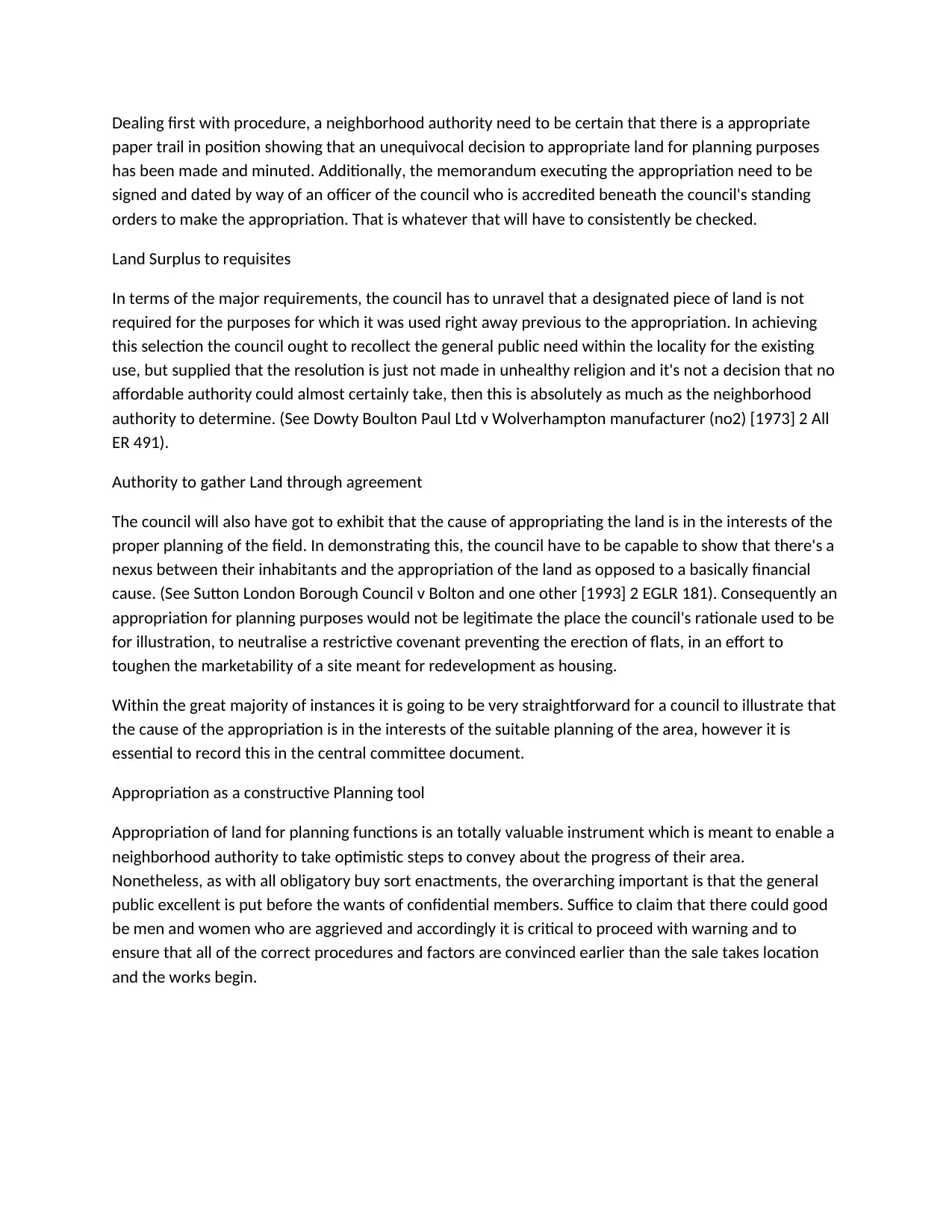
Dealing first with procedure, a neighborhood authority need to be certain that there is a appropriate
paper trail in position showing that an unequivocal decision to appropriate land for planning purposes
has been made and minuted. Additionally, the memorandum executing the appropriation need to be
signed and dated by way of an officer of the council who is accredited beneath the council's standing
orders to make the appropriation. That is whatever that will have to consistently be checked.
Land Surplus to requisites
In terms of the major requirements, the council has to unravel that a designated piece of land is not
required for the purposes for which it was used right away previous to the appropriation. In achieving
this selection the council ought to recollect the general public need within the locality for the existing
use, but supplied that the resolution is just not made in unhealthy religion and it's not a decision that no
affordable authority could almost certainly take, then this is absolutely as much as the neighborhood
authority to determine. (See Dowty Boulton Paul Ltd v Wolverhampton manufacturer (no2) [1973] 2 All
ER 491).
Authority to gather Land through agreement
The council will also have got to exhibit that the cause of appropriating the land is in the interests of the
proper planning of the field. In demonstrating this, the council have to be capable to show that there's a
nexus between their inhabitants and the appropriation of the land as opposed to a basically financial
cause. (See Sutton London Borough Council v Bolton and one other [1993] 2 EGLR 181). Consequently an
appropriation for planning purposes would not be legitimate the place the council's rationale used to be
for illustration, to neutralise a restrictive covenant preventing the erection of flats, in an effort to
toughen the marketability of a site meant for redevelopment as housing.
Within the great majority of instances it is going to be very straightforward for a council to illustrate that
the cause of the appropriation is in the interests of the suitable planning of the area, however it is
essential to record this in the central committee document.
Appropriation as a constructive Planning tool
Appropriation of land for planning functions is an totally valuable instrument which is meant to enable a
neighborhood authority to take optimistic steps to convey about the progress of their area.
Nonetheless, as with all obligatory buy sort enactments, the overarching important is that the general
public excellent is put before the wants of confidential members. Suffice to claim that there could good
be men and women who are aggrieved and accordingly it is critical to proceed with warning and to
ensure that all of the correct procedures and factors are convinced earlier than the sale takes location
and the works begin.
paper trail in position showing that an unequivocal decision to appropriate land for planning purposes
has been made and minuted. Additionally, the memorandum executing the appropriation need to be
signed and dated by way of an officer of the council who is accredited beneath the council's standing
orders to make the appropriation. That is whatever that will have to consistently be checked.
Land Surplus to requisites
In terms of the major requirements, the council has to unravel that a designated piece of land is not
required for the purposes for which it was used right away previous to the appropriation. In achieving
this selection the council ought to recollect the general public need within the locality for the existing
use, but supplied that the resolution is just not made in unhealthy religion and it's not a decision that no
affordable authority could almost certainly take, then this is absolutely as much as the neighborhood
authority to determine. (See Dowty Boulton Paul Ltd v Wolverhampton manufacturer (no2) [1973] 2 All
ER 491).
Authority to gather Land through agreement
The council will also have got to exhibit that the cause of appropriating the land is in the interests of the
proper planning of the field. In demonstrating this, the council have to be capable to show that there's a
nexus between their inhabitants and the appropriation of the land as opposed to a basically financial
cause. (See Sutton London Borough Council v Bolton and one other [1993] 2 EGLR 181). Consequently an
appropriation for planning purposes would not be legitimate the place the council's rationale used to be
for illustration, to neutralise a restrictive covenant preventing the erection of flats, in an effort to
toughen the marketability of a site meant for redevelopment as housing.
Within the great majority of instances it is going to be very straightforward for a council to illustrate that
the cause of the appropriation is in the interests of the suitable planning of the area, however it is
essential to record this in the central committee document.
Appropriation as a constructive Planning tool
Appropriation of land for planning functions is an totally valuable instrument which is meant to enable a
neighborhood authority to take optimistic steps to convey about the progress of their area.
Nonetheless, as with all obligatory buy sort enactments, the overarching important is that the general
public excellent is put before the wants of confidential members. Suffice to claim that there could good
be men and women who are aggrieved and accordingly it is critical to proceed with warning and to
ensure that all of the correct procedures and factors are convinced earlier than the sale takes location
and the works begin.
Paraphrase This Document
Need a fresh take? Get an instant paraphrase of this document with our AI Paraphraser
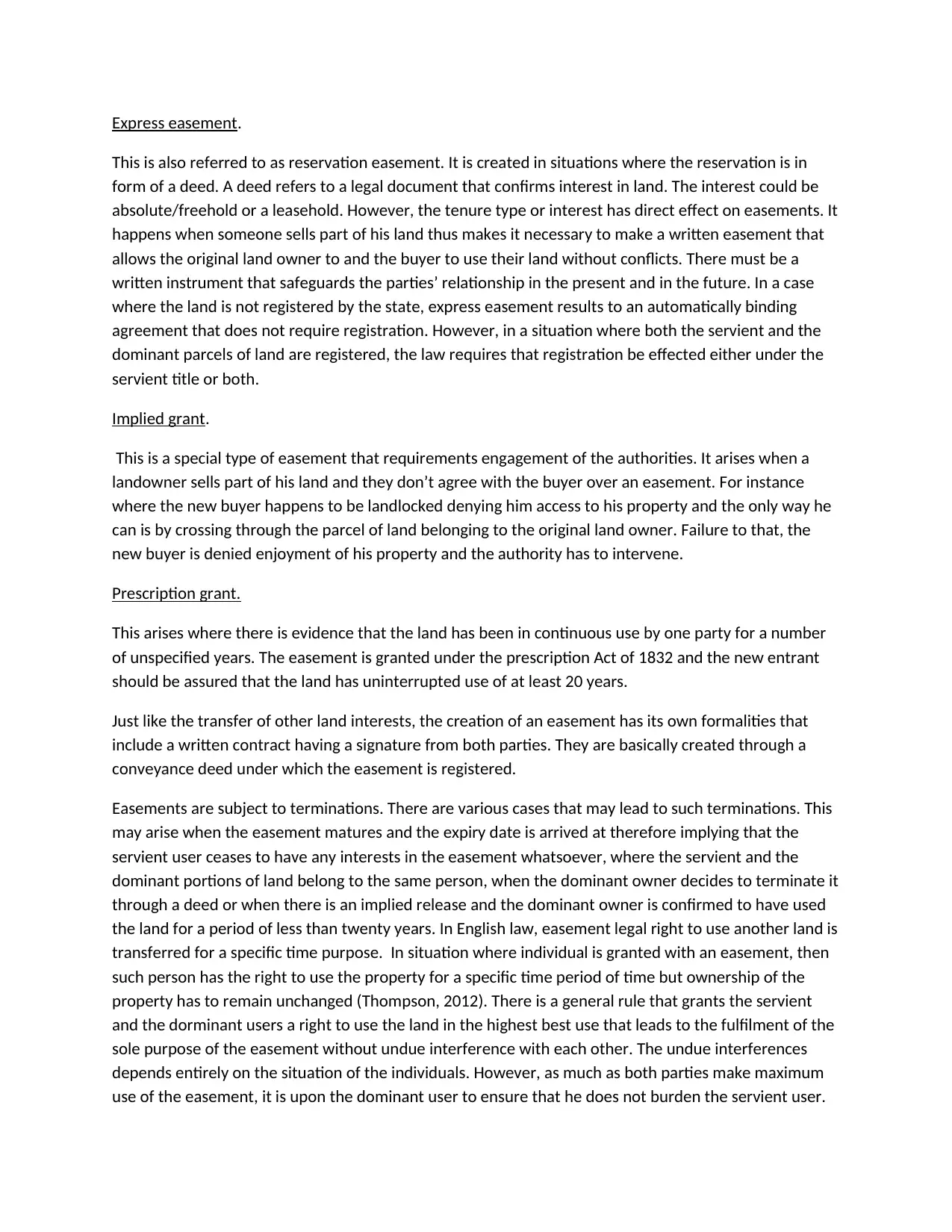
Express easement.
This is also referred to as reservation easement. It is created in situations where the reservation is in
form of a deed. A deed refers to a legal document that confirms interest in land. The interest could be
absolute/freehold or a leasehold. However, the tenure type or interest has direct effect on easements. It
happens when someone sells part of his land thus makes it necessary to make a written easement that
allows the original land owner to and the buyer to use their land without conflicts. There must be a
written instrument that safeguards the parties’ relationship in the present and in the future. In a case
where the land is not registered by the state, express easement results to an automatically binding
agreement that does not require registration. However, in a situation where both the servient and the
dominant parcels of land are registered, the law requires that registration be effected either under the
servient title or both.
Implied grant.
This is a special type of easement that requirements engagement of the authorities. It arises when a
landowner sells part of his land and they don’t agree with the buyer over an easement. For instance
where the new buyer happens to be landlocked denying him access to his property and the only way he
can is by crossing through the parcel of land belonging to the original land owner. Failure to that, the
new buyer is denied enjoyment of his property and the authority has to intervene.
Prescription grant.
This arises where there is evidence that the land has been in continuous use by one party for a number
of unspecified years. The easement is granted under the prescription Act of 1832 and the new entrant
should be assured that the land has uninterrupted use of at least 20 years.
Just like the transfer of other land interests, the creation of an easement has its own formalities that
include a written contract having a signature from both parties. They are basically created through a
conveyance deed under which the easement is registered.
Easements are subject to terminations. There are various cases that may lead to such terminations. This
may arise when the easement matures and the expiry date is arrived at therefore implying that the
servient user ceases to have any interests in the easement whatsoever, where the servient and the
dominant portions of land belong to the same person, when the dominant owner decides to terminate it
through a deed or when there is an implied release and the dominant owner is confirmed to have used
the land for a period of less than twenty years. In English law, easement legal right to use another land is
transferred for a specific time purpose. In situation where individual is granted with an easement, then
such person has the right to use the property for a specific time period of time but ownership of the
property has to remain unchanged (Thompson, 2012). There is a general rule that grants the servient
and the dorminant users a right to use the land in the highest best use that leads to the fulfilment of the
sole purpose of the easement without undue interference with each other. The undue interferences
depends entirely on the situation of the individuals. However, as much as both parties make maximum
use of the easement, it is upon the dominant user to ensure that he does not burden the servient user.
This is also referred to as reservation easement. It is created in situations where the reservation is in
form of a deed. A deed refers to a legal document that confirms interest in land. The interest could be
absolute/freehold or a leasehold. However, the tenure type or interest has direct effect on easements. It
happens when someone sells part of his land thus makes it necessary to make a written easement that
allows the original land owner to and the buyer to use their land without conflicts. There must be a
written instrument that safeguards the parties’ relationship in the present and in the future. In a case
where the land is not registered by the state, express easement results to an automatically binding
agreement that does not require registration. However, in a situation where both the servient and the
dominant parcels of land are registered, the law requires that registration be effected either under the
servient title or both.
Implied grant.
This is a special type of easement that requirements engagement of the authorities. It arises when a
landowner sells part of his land and they don’t agree with the buyer over an easement. For instance
where the new buyer happens to be landlocked denying him access to his property and the only way he
can is by crossing through the parcel of land belonging to the original land owner. Failure to that, the
new buyer is denied enjoyment of his property and the authority has to intervene.
Prescription grant.
This arises where there is evidence that the land has been in continuous use by one party for a number
of unspecified years. The easement is granted under the prescription Act of 1832 and the new entrant
should be assured that the land has uninterrupted use of at least 20 years.
Just like the transfer of other land interests, the creation of an easement has its own formalities that
include a written contract having a signature from both parties. They are basically created through a
conveyance deed under which the easement is registered.
Easements are subject to terminations. There are various cases that may lead to such terminations. This
may arise when the easement matures and the expiry date is arrived at therefore implying that the
servient user ceases to have any interests in the easement whatsoever, where the servient and the
dominant portions of land belong to the same person, when the dominant owner decides to terminate it
through a deed or when there is an implied release and the dominant owner is confirmed to have used
the land for a period of less than twenty years. In English law, easement legal right to use another land is
transferred for a specific time purpose. In situation where individual is granted with an easement, then
such person has the right to use the property for a specific time period of time but ownership of the
property has to remain unchanged (Thompson, 2012). There is a general rule that grants the servient
and the dorminant users a right to use the land in the highest best use that leads to the fulfilment of the
sole purpose of the easement without undue interference with each other. The undue interferences
depends entirely on the situation of the individuals. However, as much as both parties make maximum
use of the easement, it is upon the dominant user to ensure that he does not burden the servient user.
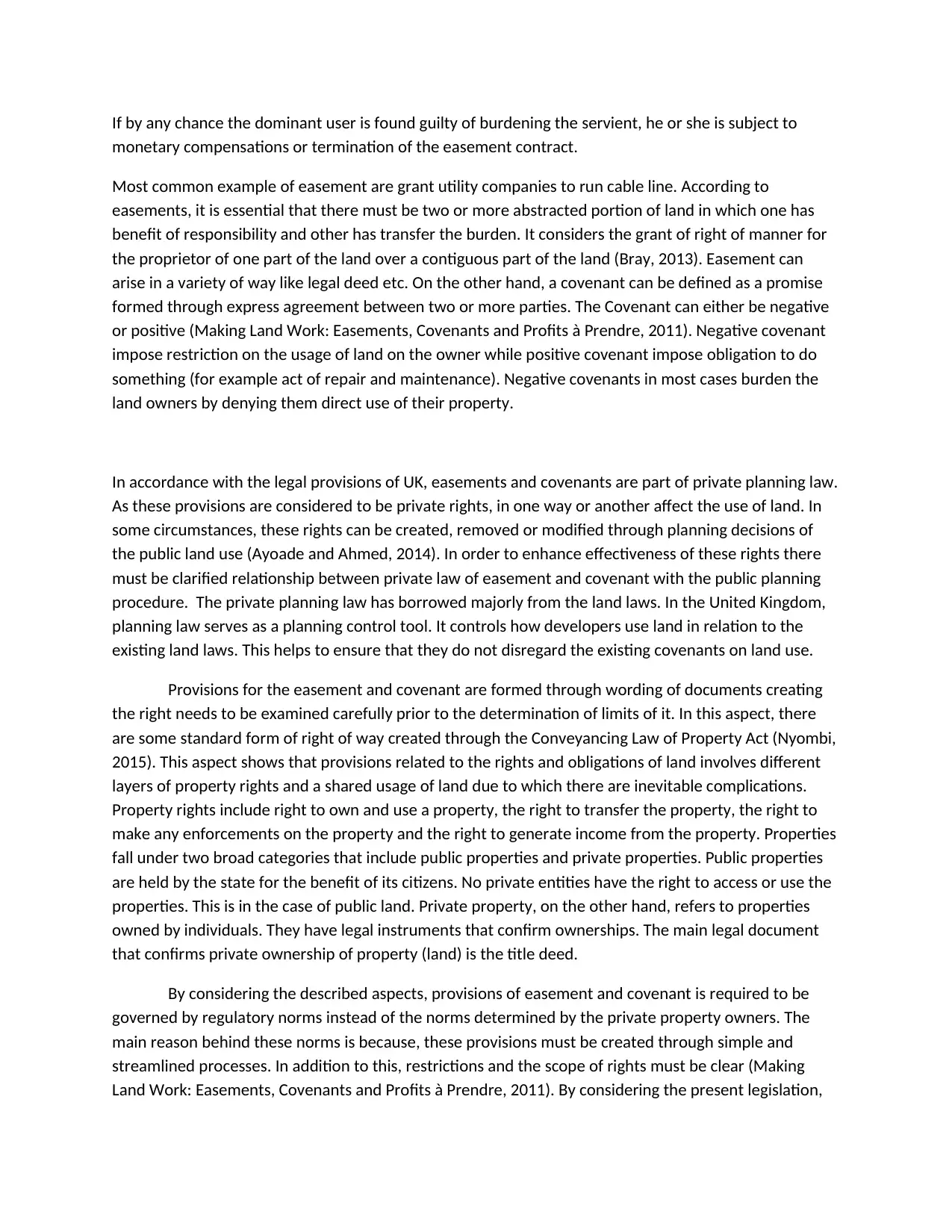
If by any chance the dominant user is found guilty of burdening the servient, he or she is subject to
monetary compensations or termination of the easement contract.
Most common example of easement are grant utility companies to run cable line. According to
easements, it is essential that there must be two or more abstracted portion of land in which one has
benefit of responsibility and other has transfer the burden. It considers the grant of right of manner for
the proprietor of one part of the land over a contiguous part of the land (Bray, 2013). Easement can
arise in a variety of way like legal deed etc. On the other hand, a covenant can be defined as a promise
formed through express agreement between two or more parties. The Covenant can either be negative
or positive (Making Land Work: Easements, Covenants and Profits à Prendre, 2011). Negative covenant
impose restriction on the usage of land on the owner while positive covenant impose obligation to do
something (for example act of repair and maintenance). Negative covenants in most cases burden the
land owners by denying them direct use of their property.
In accordance with the legal provisions of UK, easements and covenants are part of private planning law.
As these provisions are considered to be private rights, in one way or another affect the use of land. In
some circumstances, these rights can be created, removed or modified through planning decisions of
the public land use (Ayoade and Ahmed, 2014). In order to enhance effectiveness of these rights there
must be clarified relationship between private law of easement and covenant with the public planning
procedure. The private planning law has borrowed majorly from the land laws. In the United Kingdom,
planning law serves as a planning control tool. It controls how developers use land in relation to the
existing land laws. This helps to ensure that they do not disregard the existing covenants on land use.
Provisions for the easement and covenant are formed through wording of documents creating
the right needs to be examined carefully prior to the determination of limits of it. In this aspect, there
are some standard form of right of way created through the Conveyancing Law of Property Act (Nyombi,
2015). This aspect shows that provisions related to the rights and obligations of land involves different
layers of property rights and a shared usage of land due to which there are inevitable complications.
Property rights include right to own and use a property, the right to transfer the property, the right to
make any enforcements on the property and the right to generate income from the property. Properties
fall under two broad categories that include public properties and private properties. Public properties
are held by the state for the benefit of its citizens. No private entities have the right to access or use the
properties. This is in the case of public land. Private property, on the other hand, refers to properties
owned by individuals. They have legal instruments that confirm ownerships. The main legal document
that confirms private ownership of property (land) is the title deed.
By considering the described aspects, provisions of easement and covenant is required to be
governed by regulatory norms instead of the norms determined by the private property owners. The
main reason behind these norms is because, these provisions must be created through simple and
streamlined processes. In addition to this, restrictions and the scope of rights must be clear (Making
Land Work: Easements, Covenants and Profits à Prendre, 2011). By considering the present legislation,
monetary compensations or termination of the easement contract.
Most common example of easement are grant utility companies to run cable line. According to
easements, it is essential that there must be two or more abstracted portion of land in which one has
benefit of responsibility and other has transfer the burden. It considers the grant of right of manner for
the proprietor of one part of the land over a contiguous part of the land (Bray, 2013). Easement can
arise in a variety of way like legal deed etc. On the other hand, a covenant can be defined as a promise
formed through express agreement between two or more parties. The Covenant can either be negative
or positive (Making Land Work: Easements, Covenants and Profits à Prendre, 2011). Negative covenant
impose restriction on the usage of land on the owner while positive covenant impose obligation to do
something (for example act of repair and maintenance). Negative covenants in most cases burden the
land owners by denying them direct use of their property.
In accordance with the legal provisions of UK, easements and covenants are part of private planning law.
As these provisions are considered to be private rights, in one way or another affect the use of land. In
some circumstances, these rights can be created, removed or modified through planning decisions of
the public land use (Ayoade and Ahmed, 2014). In order to enhance effectiveness of these rights there
must be clarified relationship between private law of easement and covenant with the public planning
procedure. The private planning law has borrowed majorly from the land laws. In the United Kingdom,
planning law serves as a planning control tool. It controls how developers use land in relation to the
existing land laws. This helps to ensure that they do not disregard the existing covenants on land use.
Provisions for the easement and covenant are formed through wording of documents creating
the right needs to be examined carefully prior to the determination of limits of it. In this aspect, there
are some standard form of right of way created through the Conveyancing Law of Property Act (Nyombi,
2015). This aspect shows that provisions related to the rights and obligations of land involves different
layers of property rights and a shared usage of land due to which there are inevitable complications.
Property rights include right to own and use a property, the right to transfer the property, the right to
make any enforcements on the property and the right to generate income from the property. Properties
fall under two broad categories that include public properties and private properties. Public properties
are held by the state for the benefit of its citizens. No private entities have the right to access or use the
properties. This is in the case of public land. Private property, on the other hand, refers to properties
owned by individuals. They have legal instruments that confirm ownerships. The main legal document
that confirms private ownership of property (land) is the title deed.
By considering the described aspects, provisions of easement and covenant is required to be
governed by regulatory norms instead of the norms determined by the private property owners. The
main reason behind these norms is because, these provisions must be created through simple and
streamlined processes. In addition to this, restrictions and the scope of rights must be clear (Making
Land Work: Easements, Covenants and Profits à Prendre, 2011). By considering the present legislation,
⊘ This is a preview!⊘
Do you want full access?
Subscribe today to unlock all pages.

Trusted by 1+ million students worldwide
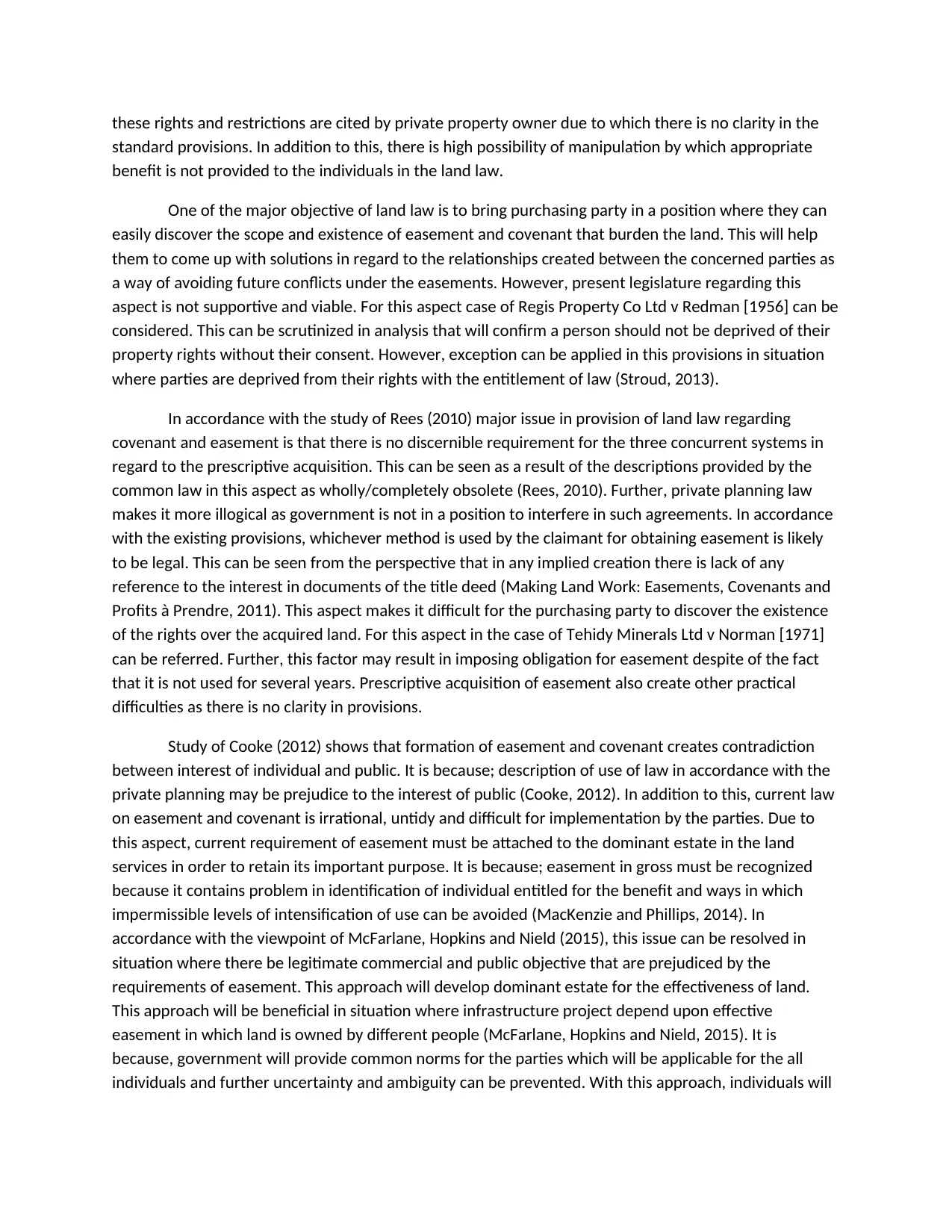
these rights and restrictions are cited by private property owner due to which there is no clarity in the
standard provisions. In addition to this, there is high possibility of manipulation by which appropriate
benefit is not provided to the individuals in the land law.
One of the major objective of land law is to bring purchasing party in a position where they can
easily discover the scope and existence of easement and covenant that burden the land. This will help
them to come up with solutions in regard to the relationships created between the concerned parties as
a way of avoiding future conflicts under the easements. However, present legislature regarding this
aspect is not supportive and viable. For this aspect case of Regis Property Co Ltd v Redman [1956] can be
considered. This can be scrutinized in analysis that will confirm a person should not be deprived of their
property rights without their consent. However, exception can be applied in this provisions in situation
where parties are deprived from their rights with the entitlement of law (Stroud, 2013).
In accordance with the study of Rees (2010) major issue in provision of land law regarding
covenant and easement is that there is no discernible requirement for the three concurrent systems in
regard to the prescriptive acquisition. This can be seen as a result of the descriptions provided by the
common law in this aspect as wholly/completely obsolete (Rees, 2010). Further, private planning law
makes it more illogical as government is not in a position to interfere in such agreements. In accordance
with the existing provisions, whichever method is used by the claimant for obtaining easement is likely
to be legal. This can be seen from the perspective that in any implied creation there is lack of any
reference to the interest in documents of the title deed (Making Land Work: Easements, Covenants and
Profits à Prendre, 2011). This aspect makes it difficult for the purchasing party to discover the existence
of the rights over the acquired land. For this aspect in the case of Tehidy Minerals Ltd v Norman [1971]
can be referred. Further, this factor may result in imposing obligation for easement despite of the fact
that it is not used for several years. Prescriptive acquisition of easement also create other practical
difficulties as there is no clarity in provisions.
Study of Cooke (2012) shows that formation of easement and covenant creates contradiction
between interest of individual and public. It is because; description of use of law in accordance with the
private planning may be prejudice to the interest of public (Cooke, 2012). In addition to this, current law
on easement and covenant is irrational, untidy and difficult for implementation by the parties. Due to
this aspect, current requirement of easement must be attached to the dominant estate in the land
services in order to retain its important purpose. It is because; easement in gross must be recognized
because it contains problem in identification of individual entitled for the benefit and ways in which
impermissible levels of intensification of use can be avoided (MacKenzie and Phillips, 2014). In
accordance with the viewpoint of McFarlane, Hopkins and Nield (2015), this issue can be resolved in
situation where there be legitimate commercial and public objective that are prejudiced by the
requirements of easement. This approach will develop dominant estate for the effectiveness of land.
This approach will be beneficial in situation where infrastructure project depend upon effective
easement in which land is owned by different people (McFarlane, Hopkins and Nield, 2015). It is
because, government will provide common norms for the parties which will be applicable for the all
individuals and further uncertainty and ambiguity can be prevented. With this approach, individuals will
standard provisions. In addition to this, there is high possibility of manipulation by which appropriate
benefit is not provided to the individuals in the land law.
One of the major objective of land law is to bring purchasing party in a position where they can
easily discover the scope and existence of easement and covenant that burden the land. This will help
them to come up with solutions in regard to the relationships created between the concerned parties as
a way of avoiding future conflicts under the easements. However, present legislature regarding this
aspect is not supportive and viable. For this aspect case of Regis Property Co Ltd v Redman [1956] can be
considered. This can be scrutinized in analysis that will confirm a person should not be deprived of their
property rights without their consent. However, exception can be applied in this provisions in situation
where parties are deprived from their rights with the entitlement of law (Stroud, 2013).
In accordance with the study of Rees (2010) major issue in provision of land law regarding
covenant and easement is that there is no discernible requirement for the three concurrent systems in
regard to the prescriptive acquisition. This can be seen as a result of the descriptions provided by the
common law in this aspect as wholly/completely obsolete (Rees, 2010). Further, private planning law
makes it more illogical as government is not in a position to interfere in such agreements. In accordance
with the existing provisions, whichever method is used by the claimant for obtaining easement is likely
to be legal. This can be seen from the perspective that in any implied creation there is lack of any
reference to the interest in documents of the title deed (Making Land Work: Easements, Covenants and
Profits à Prendre, 2011). This aspect makes it difficult for the purchasing party to discover the existence
of the rights over the acquired land. For this aspect in the case of Tehidy Minerals Ltd v Norman [1971]
can be referred. Further, this factor may result in imposing obligation for easement despite of the fact
that it is not used for several years. Prescriptive acquisition of easement also create other practical
difficulties as there is no clarity in provisions.
Study of Cooke (2012) shows that formation of easement and covenant creates contradiction
between interest of individual and public. It is because; description of use of law in accordance with the
private planning may be prejudice to the interest of public (Cooke, 2012). In addition to this, current law
on easement and covenant is irrational, untidy and difficult for implementation by the parties. Due to
this aspect, current requirement of easement must be attached to the dominant estate in the land
services in order to retain its important purpose. It is because; easement in gross must be recognized
because it contains problem in identification of individual entitled for the benefit and ways in which
impermissible levels of intensification of use can be avoided (MacKenzie and Phillips, 2014). In
accordance with the viewpoint of McFarlane, Hopkins and Nield (2015), this issue can be resolved in
situation where there be legitimate commercial and public objective that are prejudiced by the
requirements of easement. This approach will develop dominant estate for the effectiveness of land.
This approach will be beneficial in situation where infrastructure project depend upon effective
easement in which land is owned by different people (McFarlane, Hopkins and Nield, 2015). It is
because, government will provide common norms for the parties which will be applicable for the all
individuals and further uncertainty and ambiguity can be prevented. With this approach, individuals will
Paraphrase This Document
Need a fresh take? Get an instant paraphrase of this document with our AI Paraphraser
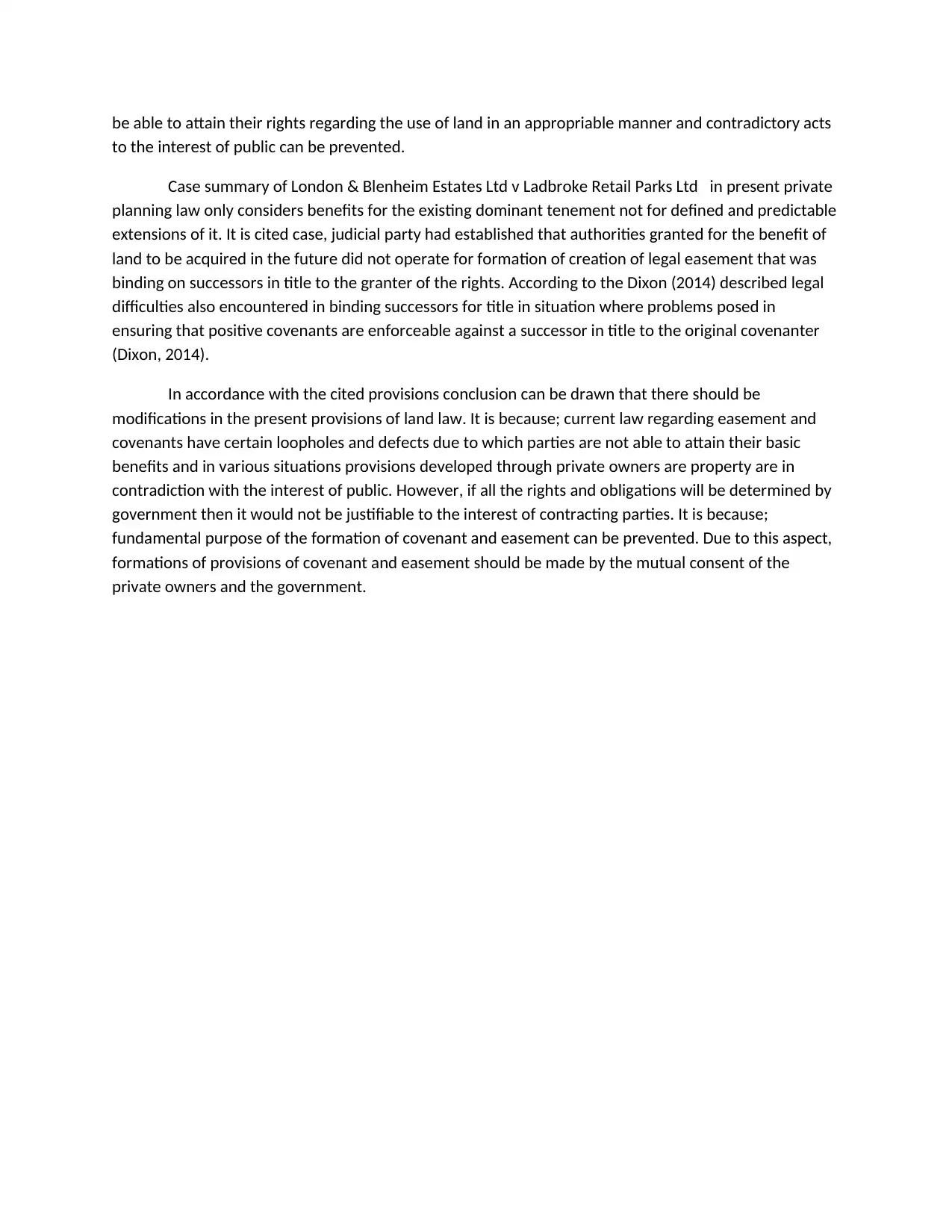
be able to attain their rights regarding the use of land in an appropriable manner and contradictory acts
to the interest of public can be prevented.
Case summary of London & Blenheim Estates Ltd v Ladbroke Retail Parks Ltd in present private
planning law only considers benefits for the existing dominant tenement not for defined and predictable
extensions of it. It is cited case, judicial party had established that authorities granted for the benefit of
land to be acquired in the future did not operate for formation of creation of legal easement that was
binding on successors in title to the granter of the rights. According to the Dixon (2014) described legal
difficulties also encountered in binding successors for title in situation where problems posed in
ensuring that positive covenants are enforceable against a successor in title to the original covenanter
(Dixon, 2014).
In accordance with the cited provisions conclusion can be drawn that there should be
modifications in the present provisions of land law. It is because; current law regarding easement and
covenants have certain loopholes and defects due to which parties are not able to attain their basic
benefits and in various situations provisions developed through private owners are property are in
contradiction with the interest of public. However, if all the rights and obligations will be determined by
government then it would not be justifiable to the interest of contracting parties. It is because;
fundamental purpose of the formation of covenant and easement can be prevented. Due to this aspect,
formations of provisions of covenant and easement should be made by the mutual consent of the
private owners and the government.
to the interest of public can be prevented.
Case summary of London & Blenheim Estates Ltd v Ladbroke Retail Parks Ltd in present private
planning law only considers benefits for the existing dominant tenement not for defined and predictable
extensions of it. It is cited case, judicial party had established that authorities granted for the benefit of
land to be acquired in the future did not operate for formation of creation of legal easement that was
binding on successors in title to the granter of the rights. According to the Dixon (2014) described legal
difficulties also encountered in binding successors for title in situation where problems posed in
ensuring that positive covenants are enforceable against a successor in title to the original covenanter
(Dixon, 2014).
In accordance with the cited provisions conclusion can be drawn that there should be
modifications in the present provisions of land law. It is because; current law regarding easement and
covenants have certain loopholes and defects due to which parties are not able to attain their basic
benefits and in various situations provisions developed through private owners are property are in
contradiction with the interest of public. However, if all the rights and obligations will be determined by
government then it would not be justifiable to the interest of contracting parties. It is because;
fundamental purpose of the formation of covenant and easement can be prevented. Due to this aspect,
formations of provisions of covenant and easement should be made by the mutual consent of the
private owners and the government.
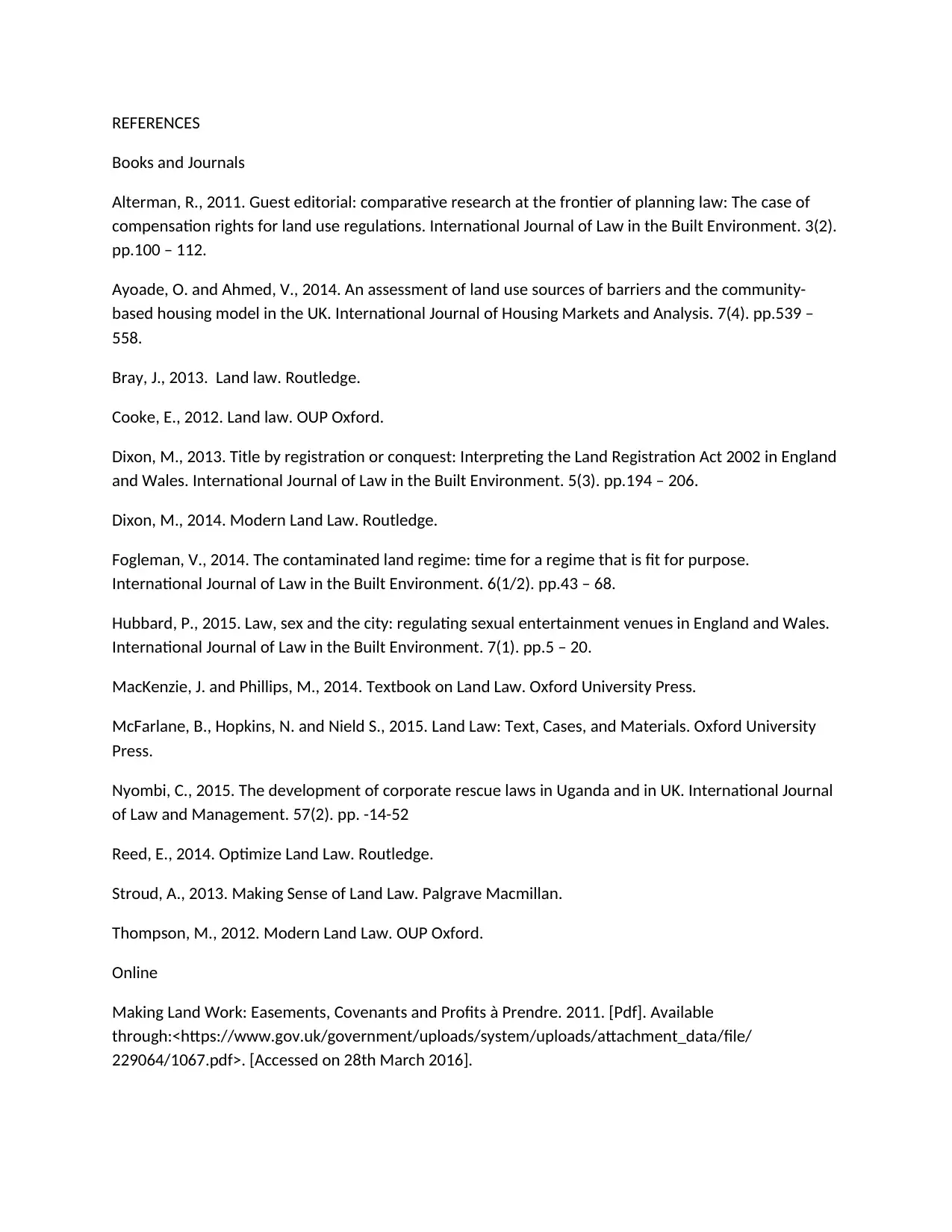
REFERENCES
Books and Journals
Alterman, R., 2011. Guest editorial: comparative research at the frontier of planning law: The case of
compensation rights for land use regulations. International Journal of Law in the Built Environment. 3(2).
pp.100 – 112.
Ayoade, O. and Ahmed, V., 2014. An assessment of land use sources of barriers and the community-
based housing model in the UK. International Journal of Housing Markets and Analysis. 7(4). pp.539 –
558.
Bray, J., 2013. Land law. Routledge.
Cooke, E., 2012. Land law. OUP Oxford.
Dixon, M., 2013. Title by registration or conquest: Interpreting the Land Registration Act 2002 in England
and Wales. International Journal of Law in the Built Environment. 5(3). pp.194 – 206.
Dixon, M., 2014. Modern Land Law. Routledge.
Fogleman, V., 2014. The contaminated land regime: time for a regime that is fit for purpose.
International Journal of Law in the Built Environment. 6(1/2). pp.43 – 68.
Hubbard, P., 2015. Law, sex and the city: regulating sexual entertainment venues in England and Wales.
International Journal of Law in the Built Environment. 7(1). pp.5 – 20.
MacKenzie, J. and Phillips, M., 2014. Textbook on Land Law. Oxford University Press.
McFarlane, B., Hopkins, N. and Nield S., 2015. Land Law: Text, Cases, and Materials. Oxford University
Press.
Nyombi, C., 2015. The development of corporate rescue laws in Uganda and in UK. International Journal
of Law and Management. 57(2). pp. -14-52
Reed, E., 2014. Optimize Land Law. Routledge.
Stroud, A., 2013. Making Sense of Land Law. Palgrave Macmillan.
Thompson, M., 2012. Modern Land Law. OUP Oxford.
Online
Making Land Work: Easements, Covenants and Profits à Prendre. 2011. [Pdf]. Available
through:<https://www.gov.uk/government/uploads/system/uploads/attachment_data/file/
229064/1067.pdf>. [Accessed on 28th March 2016].
Books and Journals
Alterman, R., 2011. Guest editorial: comparative research at the frontier of planning law: The case of
compensation rights for land use regulations. International Journal of Law in the Built Environment. 3(2).
pp.100 – 112.
Ayoade, O. and Ahmed, V., 2014. An assessment of land use sources of barriers and the community-
based housing model in the UK. International Journal of Housing Markets and Analysis. 7(4). pp.539 –
558.
Bray, J., 2013. Land law. Routledge.
Cooke, E., 2012. Land law. OUP Oxford.
Dixon, M., 2013. Title by registration or conquest: Interpreting the Land Registration Act 2002 in England
and Wales. International Journal of Law in the Built Environment. 5(3). pp.194 – 206.
Dixon, M., 2014. Modern Land Law. Routledge.
Fogleman, V., 2014. The contaminated land regime: time for a regime that is fit for purpose.
International Journal of Law in the Built Environment. 6(1/2). pp.43 – 68.
Hubbard, P., 2015. Law, sex and the city: regulating sexual entertainment venues in England and Wales.
International Journal of Law in the Built Environment. 7(1). pp.5 – 20.
MacKenzie, J. and Phillips, M., 2014. Textbook on Land Law. Oxford University Press.
McFarlane, B., Hopkins, N. and Nield S., 2015. Land Law: Text, Cases, and Materials. Oxford University
Press.
Nyombi, C., 2015. The development of corporate rescue laws in Uganda and in UK. International Journal
of Law and Management. 57(2). pp. -14-52
Reed, E., 2014. Optimize Land Law. Routledge.
Stroud, A., 2013. Making Sense of Land Law. Palgrave Macmillan.
Thompson, M., 2012. Modern Land Law. OUP Oxford.
Online
Making Land Work: Easements, Covenants and Profits à Prendre. 2011. [Pdf]. Available
through:<https://www.gov.uk/government/uploads/system/uploads/attachment_data/file/
229064/1067.pdf>. [Accessed on 28th March 2016].
⊘ This is a preview!⊘
Do you want full access?
Subscribe today to unlock all pages.

Trusted by 1+ million students worldwide

Rees, N., 2010. EASEMENTS AND COVENANTS. [Pdf]. Available
through:<http://www.lawreform.vic.gov.au/sites/default/files/EandC_Final_Report.pdf> [Accessed on
28th March 2016].
through:<http://www.lawreform.vic.gov.au/sites/default/files/EandC_Final_Report.pdf> [Accessed on
28th March 2016].
1 out of 10
Related Documents
Your All-in-One AI-Powered Toolkit for Academic Success.
+13062052269
info@desklib.com
Available 24*7 on WhatsApp / Email
![[object Object]](/_next/static/media/star-bottom.7253800d.svg)
Unlock your academic potential
Copyright © 2020–2025 A2Z Services. All Rights Reserved. Developed and managed by ZUCOL.





